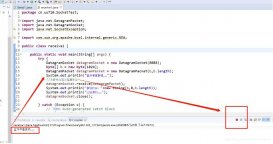1、单词逆序。
要求从控制台读入一串字符,按回车结束输入,同时显示其逆序字符串。
对于颠倒顺序的操作,用栈来解决是很方便的。具体思想是把字符串中的每一个字符按顺序存入栈中,然后再一个一个的从栈中取出。这时就是按照逆序取出的字符串。
|
1
2
3
4
5
6
7
8
9
10
11
12
13
14
15
16
17
18
19
20
21
22
23
24
25
26
27
28
29
30
31
32
33
34
35
36
37
38
39
40
41
42
43
44
45
46
47
48
49
50
51
52
53
54
55
56
57
58
59
60
61
62
63
64
65
66
67
68
69
70
71
72
73
74
75
76
77
78
79
80
81
82
83
84
85
86
87
88
89
90
91
92
93
94
95
96
97
98
99
|
// reverse.java // stack used to reverse a string // to run this program: C>java ReverseApp import java.io.*; // for I/O //////////////////////////////////////////////////////////////// class StackX//定义了栈的基本结构和操作 { private int maxSize;//栈最大值 private char[] stackArray;//栈内用数组存储数据 private int top;//当前栈顶标号,从0开始 //-------------------------------------------------------------- public StackX(int max) // constructor { maxSize = max; stackArray = new char[maxSize]; top = -1; } //-------------------------------------------------------------- public void push(char j) // put item on top of stack { stackArray[++top] = j; } //-------------------------------------------------------------- public char pop() // take item from top of stack { return stackArray[top--]; } //-------------------------------------------------------------- public char peek() // peek at top of stack { return stackArray[top]; } //-------------------------------------------------------------- public boolean isEmpty() // true if stack is empty { return (top == -1); } //-------------------------------------------------------------- } // end class StackX //////////////////////////////////////////////////////////////// class Reverser//封装了单词逆序的操作 { private String input; // input string private String output; // output string //-------------------------------------------------------------- public Reverser(String in) // constructor { input = in; } //-------------------------------------------------------------- public String doRev() // reverse the string { int stackSize = input.length(); // get max stack size StackX theStack = new StackX(stackSize); // make stack for(int j=0; j<input.length(); j++) { char ch = input.charAt(j); // get a char from input theStack.push(ch); // push it } output = ""; while( !theStack.isEmpty() ) { char ch = theStack.pop(); // pop a char, output = output + ch; // append to output } return output; } // end doRev() //-------------------------------------------------------------- } // end class Reverser //////////////////////////////////////////////////////////////// class ReverseApp { public static void main(String[] args) throws IOException { String input, output; while(true) { System.out.print("Enter a string: "); System.out.flush(); input = getString(); // read a string from kbd if( input.equals("") ) // 若没有输入字符串直接按回车,则结束 break; // make a Reverser Reverser theReverser = new Reverser(input); output = theReverser.doRev(); // use it System.out.println("Reversed: " + output); } // end while System.out.println("this is end"); } // end main() //-------------------------------------------------------------- public static String getString() throws IOException { InputStreamReader isr = new InputStreamReader(System.in); BufferedReader br = new BufferedReader(isr); String s = br.readLine(); return s; } //-------------------------------------------------------------- } // end class ReverseApp //////////////////////////////////////////////////////////////// |
2.分隔符匹配
有些分割符在编程中一定是成对出现的,例如(),{},和[]等。如果发现有未匹配的分隔符,编译器会报错。因为匹配操作采取就近原则,后输入的分割符优先匹配,具有“后进先出”的特点。这个匹配操作可以用栈来实现。
具体操作是在输入过程中,如果遇到左匹配符,则将左匹配符压入栈中。如果遇到右匹配符,则从栈中取出一个数据,分析其与右匹配符是否相匹配。若匹配,则继续进行,若不匹配,则报错终止。
|
1
2
3
4
5
6
7
8
9
10
11
12
13
14
15
16
17
18
19
20
21
22
23
24
25
26
27
28
29
30
31
32
33
34
35
36
37
38
39
40
41
42
43
44
45
46
47
48
49
50
51
52
53
54
55
56
57
58
59
60
61
62
63
64
65
66
67
68
69
70
71
72
73
74
75
76
77
78
79
80
81
82
83
84
85
86
87
88
89
90
91
92
93
94
95
96
97
98
99
100
101
102
103
104
105
106
107
108
109
110
111
112
113
114
115
116
117
|
// brackets.java // stacks used to check matching brackets // to run this program: C>java bracketsApp import java.io.*; // for I/O //////////////////////////////////////////////////////////////// class StackX { private int maxSize; private char[] stackArray; private int top; //-------------------------------------------------------------- public StackX(int s) // constructor { maxSize = s; stackArray = new char[maxSize]; top = -1; } //-------------------------------------------------------------- public void push(char j) // put item on top of stack { stackArray[++top] = j; } //-------------------------------------------------------------- public char pop() // take item from top of stack { return stackArray[top--]; } //-------------------------------------------------------------- public char peek() // peek at top of stack { return stackArray[top]; } //-------------------------------------------------------------- public boolean isEmpty() // true if stack is empty { return (top == -1); } //-------------------------------------------------------------- } // end class StackX //////////////////////////////////////////////////////////////// class BracketChecker { private String input; // input string //-------------------------------------------------------------- public BracketChecker(String in) // constructor { input = in; } //-------------------------------------------------------------- public void check() { int stackSize = input.length(); // get max stack size StackX theStack = new StackX(stackSize); // make stack for(int j=0; j<input.length(); j++) // get chars in turn { char ch = input.charAt(j); // get char switch(ch) { case '{': // opening symbols case '[': case '(': theStack.push(ch); // push them break; case '}': // closing symbols case ']': case ')': if( !theStack.isEmpty() ) // if stack not empty, { char chx = theStack.pop(); // pop and check if( (ch=='}' && chx!='{') || (ch==']' && chx!='[') || (ch==')' && chx!='(') )//分隔符不匹配 System.out.println("Error: "+ch+" at "+j); } else // prematurely empty System.out.println("Error: "+ch+" at "+j); break; default: // no action on other characters break; } // end switch } // end for // at this point, all characters have been processed if( !theStack.isEmpty() ) System.out.println("Error: missing right delimiter"); } // end check() //-------------------------------------------------------------- } // end class BracketChecker //////////////////////////////////////////////////////////////// class BracketsApp { public static void main(String[] args) throws IOException { String input; while(true) { System.out.print( "Enter string containing delimiters: "); System.out.flush(); input = getString(); // read a string from kbd if( input.equals("") ) // quit if [Enter] break; // make a BracketChecker BracketChecker theChecker = new BracketChecker(input); theChecker.check(); // check brackets } // end while } // end main() //-------------------------------------------------------------- public static String getString() throws IOException { InputStreamReader isr = new InputStreamReader(System.in); BufferedReader br = new BufferedReader(isr); String s = br.readLine(); return s; } //-------------------------------------------------------------- } // end class BracketsApp //////////////////////////////////////////////////////////////// |
感谢阅读,希望能帮助到大家,谢谢大家对本站的支持!
原文链接:http://blog.csdn.net/xiaokang123456kao/article/details/54089360














